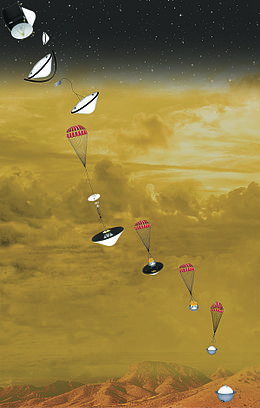DaVinci

Artist's concept of DAVINCI probe descent stages
|
|
| Mission type | Venus atmospheric probe |
|---|---|
| Operator | NASA Goddard Space Flight Center |
| Start of mission | |
| Launch date | 2021 (proposed) |
| Venus atmospheric probe | |
DAVINCI (Deep Atmosphere Venus Investigation of Noble gases, Chemistry, and Imaging) is a proposed mission concept for an atmospheric probe to Venus.
DAVINCI would study the chemical composition of Venus' atmosphere during descent. The DAVINCI probe would travel through the Venus atmosphere, sampling the air, and returning measurements down to the surface. These measurements are important to understanding the origin of the Venus atmosphere, how it has evolved, and how and why it is different from Earth and Mars. DAVINCI’s measurements would reveal the history of water on Venus and the chemical processes at work in the unexplored lower atmosphere. Before it reaches the surface, the DAVINCI probe would take the first ever photos of the planet’s intriguing, ridged terrain (“tesserae”) to explore its origin and tectonic, volcanic, and weathering history.
DAVINCI was one of dozens of proposals submitted in 2015 to potentially become Mission #13 of NASA’s Discovery Program. NASA’s planned budget for Discovery Mission #13 is 450 million USD. On September 30, 2015 it was selected as one of five finalists. On January 4, 2017, two competing proposals, Lucy and Psyche, defeated DAVINCI to be selected as the 13th and 14th Discovery missions, respectively.
The DAVINCI principal investigator is Lori Glaze and the deputy principal investigator is James Garvin, both of NASA’s Goddard Space Flight Center.
Following five orbital missions to Venus (Venera 15, Venera 16, Magellan, Venus Express, Akatsuki) focused on remote sensing observations, DAVINCI would be the first probe since 1986 to target Venus’ atmosphere. DAVINCI will directly measure the lower two-thirds of the atmospheric mass.
DAVINCI scientists would explore how Venus’ atmosphere formed and then changed over time, including what happened to its water. The findings would help scientists understand why Venus and Earth took such different paths as they matured, and provide another point of comparison for studies of rocky planets in other star systems (exoplanets).
...
Wikipedia
